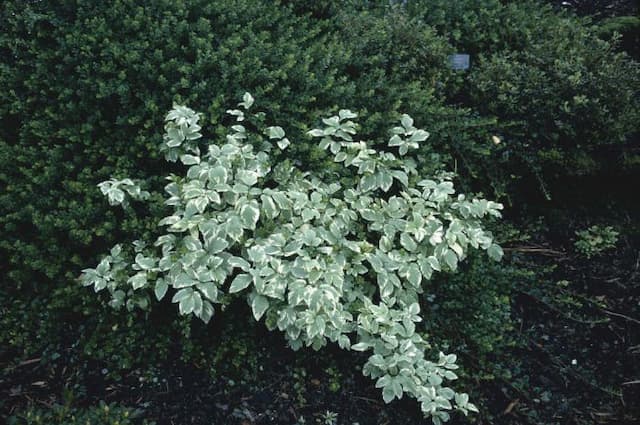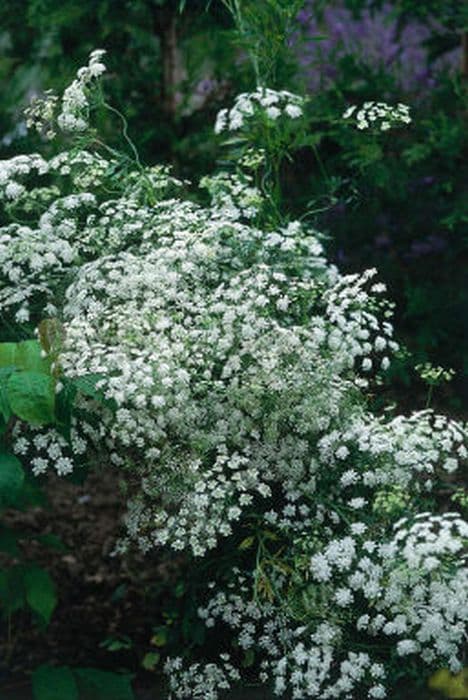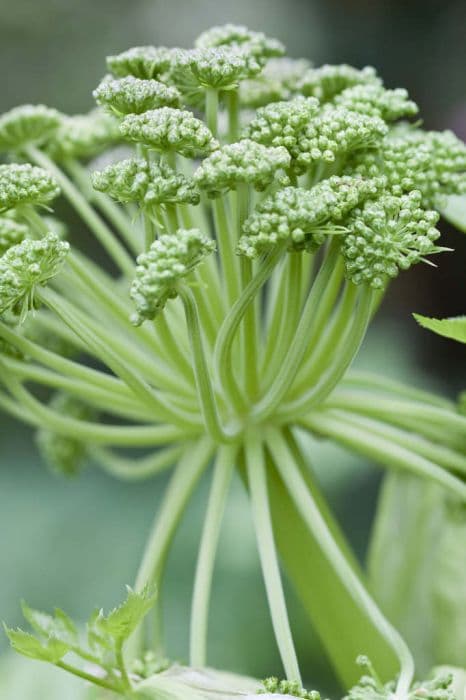Alpine Sea Holly Eryngium alpinum 'Blue Star'

ABOUT
Eryngium alpinum 'Blue Star', commonly known as the alpine sea holly, is a striking perennial plant known for its unique appearance. The plant's most notable feature is its thistle-like flower heads that are a striking metallic blue color. These flower heads are surrounded by a ruff of spiny bracts, which also possess a similar blue hue, creating a contrasting effect against the green foliage. The leaves of the alpine sea holly are equally interesting, with a coarse texture and a deep green color that may also have hints of blue. These leaves are often spiny-edged and shaped like elongated hearts or lances. The stems of the 'Blue Star' variety are stiff and branched, each one ending in a flower head. The overall look of the plant is one of structured elegance, with a touch of wild, natural charm due to the spiky appearance of the flowers and foliage. It has a distinctive architectural quality that makes it a favorite in ornamental gardens for adding visual interest and attracting pollinators like bees and butterflies. Despite its common name suggesting a mountain origin, the alpine sea holly carries an appearance that allows it to blend seamlessly with various garden styles. The striking blue color and unique form provide a focal point among softer, more traditional garden plants. The hardy nature of Eryngium alpinum 'Blue Star' also contributes to its appeal among gardeners who admire both its beauty and resilience.
About this plant
 Names
NamesFamily
Apiaceae
Synonyms
Alpine Sea Holly, Blue Star Sea Holly, Alpine Eryngo
Common names
Eryngium alpinum.
 Toxicity
ToxicityTo humans
Alpine sea holly is not commonly known to be toxic to humans. There is no significant evidence suggesting that ingestion or handling of Alpine sea holly causes poisoning or adverse health effects in humans. However, as with many plants, individual allergies or sensitivities may exist, so it is always prudent to handle plants with care and avoid ingestion unless they are known to be edible.
To pets
Alpine sea holly is also not known to be toxic to pets. It does not appear on lists of poisonous plants for pets, which suggests that it is generally considered to be safe around animals. However, just like with humans, pets may have individual sensitivities, and ingesting non-food items can sometimes lead to gastrointestinal distress or other issues. Thus, it's still a good practice to prevent pets from ingesting plants not intended for consumption.
 Characteristics
CharacteristicsLife cycle
Perennials
Foliage type
Deciduous
Color of leaves
Green
Flower color
Blue
Height
2 feet (60 cm)
Spread
1 foot (30 cm)
Plant type
Herb
Hardiness zones
5
Native area
Europe
Benefits
 General Benefits
General Benefits- Attracts Pollinators: Eryngium alpinum 'Blue Star', commonly known as alpine sea holly, is known to attract bees, butterflies, and other beneficial insects to gardens, helping to pollinate plants.
- Drought Tolerant: Once established, alpine sea holly has low water requirements, making it suitable for xeriscape gardens and areas with water restrictions.
- Low Maintenance: This plant requires minimal care once established, with no need for frequent watering or fertilizing, making it ideal for gardeners seeking low-maintenance options.
- Deer Resistant: The alpine sea holly's spiny foliage makes it unattractive to deer, so it is less likely to be browsed by wildlife.
- Long Blooming Season: With a blooming period from midsummer to early fall, alpine sea holly provides long-lasting color and interest in the garden.
- Architectural Interest: The striking blue flowers and unique spiky texture of alpine sea holly add architectural interest and can be used as a focal point in garden design.
- Cut and Dried Flower Use: The blooms and seed heads are excellent for both fresh and dried floral arrangements, retaining their color and shape well when dried.
- Soil Versatility: Eryngium alpinum 'Blue Star' is adaptable to a range of soil types, although it prefers well-drained soil, making it suitable for various garden situations.
- Hardy Nature: Being cold hardy, alpine sea holly can withstand frost and thrive in cooler climates.
- Ornamental Seeds: The ornamental seed heads provide visual interest throughout the fall and into the winter, even after the flowering period ends.
 Medical Properties
Medical Properties- Anti-inflammatory: Eryngium alpinum 'Blue Star' has been traditionally used for its potential anti-inflammatory properties.
- Diuretic: The plant may have diuretic effects, which can help in increasing the passing of urine.
- Antitussive effect: It has been used to alleviate coughs through its soothing properties on the throat and respiratory system.
 Air-purifying Qualities
Air-purifying QualitiesThis plant is not specifically known for air purifying qualities.
 Other Uses
Other Uses- Eryngium alpinum 'Blue Star', commonly known as Alpine Sea Holly, can be used in dried floral arrangements, providing a unique texture and retaining its color well after drying.
- The spiky foliage and bristly flower heads of Alpine Sea Holly are sometimes used in natural pest control, as their texture can be deterrent to some garden pests.
- Alpine Sea Holly has been used in heritage crafts, such as the creation of traditional wreaths and natural decorations for its distinctive appearance.
- This plant is sometimes incorporated into fashion design, with its striking blue flowers being used as inspirations, or actual components, of avant-garde headpieces and accessories.
- The distinctive shape of Alpine Sea Holly's flowers allows them to be cast in metal or resin for use in ornamental art or jewelry making.
- Gardeners plant Alpine Sea Holly to create a visually striking border with its unique color and form that contrasts well with other garden plants.
- The thistle-like appearance of Alpine Sea Holly is occasionally used in symbolic art, representing resilience or protection.
- Its robust nature allows Alpine Sea Holly to be used in educational projects about plant adaptation and survival in difficult soil conditions, such as rockeries or alpine beds.
- Because of its strong stems and unique look, Alpine Sea Holly can be used as a natural support for more delicate climbing plants when planted in proximity.
- Its intense blue color is sometimes considered in color therapy and psychological studies dealing with human response to color in nature.
Interesting Facts
 Feng Shui
Feng ShuiThe Sea Holly is not used in Feng Shui practice.
 Zodiac Sign Compitability
Zodiac Sign CompitabilityThe Sea Holly is not used in astrology practice.
 Plant Symbolism
Plant Symbolism- Determination: The Eryngium alpinum 'Blue Star', commonly known as Alpine Sea Holly, features spiky bracts and a tough demeanor that can symbolize a resilient and determined spirit.
- Protection: With its spiny and hard texture, the Alpine Sea Holly can represent defense and protection, suggesting a shield against adversity.
- Attraction: Because of its unique appearance and striking blue color, Alpine Sea Holly could symbolize attraction or a magnetic personality, as it stands out in a garden setting.
- Independence: Alpine Sea Holly is able to grow in poor soils and handle drought-like conditions, which may symbolize independence and self-sufficiency.
- Nobility: In some traditions, the thistle-like appearance of the Alpine Sea Holly is associated with nobility and the aristocracy, reflecting an air of grace and dignity.
 Water
WaterAlpine sea holly should be watered deeply and less frequently to encourage a strong root system. Initially, after planting 'Blue Star,' water it once a week with about 1-2 gallons, depending on the soil and weather conditions. Once established, the plant is quite drought-tolerant, so you can reduce watering to every two weeks or less, as the plant prefers drier soils. Always check the moisture level of the soil before watering to prevent overwatering; the soil should be allowed to dry out slightly between waterings. During extremely hot or dry periods, additional water may be necessary.
 Light
LightAlpine sea holly flourishes best in full sun conditions which means it requires at least 6 hours of direct sunlight daily. The best spot for 'Blue Star' is in an area where it can receive unfiltered sunlight throughout the day. If you’re growing it in a garden, plant it in a location free from the shade of trees or buildings to ensure optimal light exposure.
 Temperature
TemperatureAlpine sea holly 'Blue Star' can tolerate a range of temperatures, but it performs best in moderate conditions. It can survive temperatures as low as 0 degrees Fahrenheit in winter and as high as 85 to 90 degrees Fahrenheit in summer. Ideal conditions for Alpine sea holly sit between 60 and 70 degrees Fahrenheit where it can thrive without stress from extreme heat or cold.
 Pruning
PruningPruning Alpine sea holly 'Blue Star' is generally done to remove spent flowers or to shape the plant. Prune the spent flowers after blooming to encourage additional blooms and to prevent self-sowing if not desired. The best time for pruning is late winter or early spring, before new growth begins. Periodic removal of old leaves and damaged stems can also keep the plant looking clean and healthy.
 Cleaning
CleaningAs needed
 Soil
SoilAlpine Sea Holly, or Eryngium alpinum 'Blue Star', thrives in well-drained soil that is not too rich in nutrients, with a preference for a neutral to slightly alkaline pH between 6.5 and 7.5. A gritty loam or sandy soil mixed with gravel or shredded bark promotes good drainage. Regular garden soil can be improved by adding perlite or sand to enhance drainage, crucial for the plant's root health.
 Repotting
RepottingAlpine Sea Holly does not need frequent repotting and can often remain in the same pot for several years. It is typically repotted only when it has clearly outgrown its current container, which may be every 3-4 years. Care should be taken not to disturb the roots excessively during repotting as the plant can be sensitive to root disturbance.
 Humidity & Misting
Humidity & MistingAlpine Sea Holly is tolerant of a wide range of humidity levels but prefers a drier environment, which mirrors its natural alpine habitat. It does not require high humidity and will thrive in average room humidity levels.
 Suitable locations
Suitable locationsIndoor
Grow in bright light, on a well-drained soil mix, minimal watering.
Outdoor
Full sun, very well-drained soil, protect from winter wet.
Hardiness zone
4-8 USDA
 Life cycle
Life cycleThe 'Blue Star' sea holly, or Eryngium alpinum 'Blue Star', starts its life cycle when its seeds germinate in late winter or spring, given the right conditions of cool temperatures and moisture. The seedlings develop into rosettes of spiky, green leaves during the first year, focusing mainly on establishing a strong root system. In its second year, the plant enters the vegetative growth stage, where stems elongate, and leaves begin to take on a bluer hue if grown in full sun and well-draining soil. During mid-summer, 'Blue Star' sea holly produces its striking blue to purple thistle-like flowers, attracting pollinators such as bees and butterflies. After flowering, the plant sets seeds, which mature by late summer or early autumn and disperse for the next generation. Finally, Eryngium alpinum 'Blue Star' is a perennial, so after seed set, the above-ground parts may die back in winter, but the plant will re-emerge from its rootstock the following spring.
 Propogation
PropogationPropogation time
Summer
The Eryngium alpinum 'Blue Star', commonly known as Alpine Sea Holly, is often propagated by seed. Sowing seeds can be done in late winter to early spring. To propagate by seed, distribute the tiny seeds evenly across the surface of a well-draining seed starting mix in a container, then lightly cover them with a thin layer of soil. It's important to maintain a consistent temperature of about 70 degrees Fahrenheit (21 degrees Celsius) and to keep the soil moist, but not waterlogged, to facilitate germination. Germination can take a few weeks, and once seedlings are large enough to handle, they can be transplanted into individual pots. Growth is slow initially, but once established, the plants are quite hardy.









